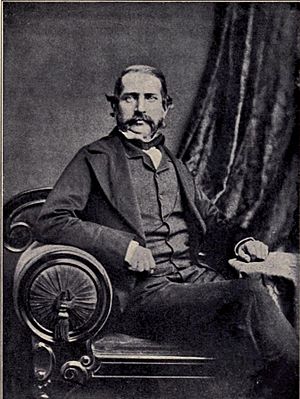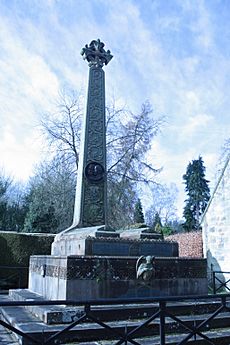Richard Baird Smith facts for kids
Quick facts for kids
Richard Baird Smith
|
|
|---|---|
 |
|
| Born | 31 December 1818 |
| Died | 13 December 1861 (aged 42) |
| Occupation | Engineer official |
| Known for | Chief Engineer during the Siege of Delhi |
| Spouse(s) | Florence Elizabeth |
| Children | Florence May Smith Margaret Eleanor Smith |
Richard Baird Smith (born December 31, 1818 – died December 13, 1861) was a British engineer. He worked for the East India Company, a powerful British trading company. He became famous for his important role as the Chief Engineer during the Siege of Delhi in 1857.
Contents
Early Life and Education
Richard Baird Smith was born in Lasswade, Scotland, on December 31, 1818. His father, Richard Smith, was a doctor. Richard Baird Smith went to school in Lasswade and later at Duns Academy.
A Career in Engineering

Baird Smith joined the East India Company's Military Seminary. This was a special school for future officers. He became an officer in December 1836. In 1838, he joined the Madras Engineers, a group of military engineers.
Later, he moved to the Bengal Engineers. He fought in the Second Anglo-Sikh War. He was present at important battles like Aliwal and Sobraon.
Working on Canals
After the wars, Baird Smith spent several years working on canals. Canals are man-made waterways. He was in charge of this work in a place called Roorkee.
Role in the Indian Rebellion of 1857
When a big uprising, known as the Indian Rebellion of 1857, started, Baird Smith was still in Roorkee. He quickly gathered all the Europeans in the workshops. This helped to keep everyone safe. Even though some local soldiers left, no lives were lost thanks to his quick thinking.
The Siege of Delhi
Baird Smith was made the chief engineer for the Siege of Delhi. A siege is when an army surrounds a city to try and capture it. He arrived in Delhi in late July. He immediately suggested attacking the city.
However, the general in charge, General Barnard, died. The next general, General Reed, did not follow Baird Smith's advice. When General Reed was replaced by General Archdale Wilson, the attacking army was weaker.
Baird Smith insisted that they should not give up on Delhi. He waited for more soldiers and supplies to arrive. These came with John Nicholson. Together, Baird Smith and Nicholson convinced General Wilson to attack. The attack happened on September 14 and was successful. Delhi was captured.
After the capture of Delhi, Baird Smith went back to his work on canals. For a while, his important military work was not fully recognized.
Later Achievements
After the rebellion, Baird Smith became an aide-de-camp to Queen Victoria. This meant he was a personal assistant to the Queen. He also became a secretary for public works in the government of India. He earned praise for his work during a famine in 1861. A famine is a time when there is not enough food.
However, his hard work and a wound he got in Delhi made him very ill. He died at sea on December 13, 1861.
Family Life
Richard Baird Smith married Florence Elizabeth in 1856. She was the daughter of a writer named Thomas De Quincey. They had two daughters, Florence May and Margaret Eleanor.
Memorials
There are memorials to Richard Baird Smith. One is in St Paul's Cathedral in Calcutta, India. Another very large memorial stands in his hometown of Lasswade, Scotland. It honors both him and his father.

